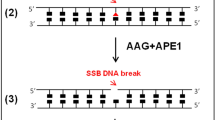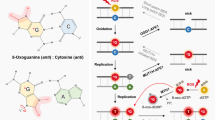Abstract
Homocysteine is considered to be an important risk factor for cancer as well as cardiovascular diseases. To clarify whether homocysteine has potential carcinogenicity, we investigated formation of 8-oxo-7,8-dihydro-2′-deoxyguanosine (8-oxodG), which is known to be correlated with the incidence of cancer, induced by homocysteine in human cultured cell lines. Homocysteine increased the amount of 8-oxodG in human leukemia cell line HL-60, whereas the amount of 8-oxodG in its hydrogen peroxide (H2O2)-resistant clone HP100 was not increased. We investigated the mechanism for oxidative DNA damage by homocysteine using 32P-labeled DNA fragments obtained from human tumor suppressor genes and a proto-oncogene. There were two mechanisms by which homocysteine caused DNA damage in the presence of Cu(II). A low concentration of homocysteine (20 μ M) frequently induced piperidine-labile sites at thymine residues, whereas a high concentration of homocysteine (100 μ M) resulted in damage principally to guanine residues. Catalase inhibited DNA damage by 20 μ M homocysteine, indicating the participation of H2O2, but was ineffective in preventing DNA damage by 100 μ M homocysteine. Experiments using a singlet oxygen probe showed that 100 μ M homocysteine enhanced chemiluminescence intensity in deuterium oxide more than that in H2O. These results indicated that the metal-dependent DNA damage through H2O2 is likely to be a more relevant mechanism for homocysteine carcinogenicity.
This is a preview of subscription content, access via your institution
Access options
Subscribe to this journal
Receive 50 print issues and online access
$259.00 per year
only $5.18 per issue
Buy this article
- Purchase on Springer Link
- Instant access to full article PDF
Prices may be subject to local taxes which are calculated during checkout







Similar content being viewed by others
Abbreviations
- 8-oxodG:
-
8-oxo-7,8-dihydro-2′-deoxyguanosine
- DTPA:
-
diethylenetriamine-N,N,N′,N″,N″-pentaacetic acid
- SOD:
-
superoxide dismutase
- H2O2:
-
hydrogen peroxide
- HPLC:
-
high-performance liquid chromatography
- HPLC-ECD:
-
electrochemical detector coupled to HPLC
- •OH:
-
hydroxyl free radical
- O2−:
-
superoxide anion
- MVP:
-
trans-1-(2′-methoxyvinyl)pyrene
- 1O2:
-
singlet oxygen
- D2O:
-
deuterium oxide
- MTHFR:
-
methylenetetrahydrofolate reductase gene
- DABCO:
-
1,4-diazabicyclo[2,2,2]-octane
References
Ames BN . (1999). Ann. NY Acad. Sci., 889, 87–106.
Bannai S . (1984). Biochim. Biophys. Acta, 779, 289–306.
Blom HJ . (1998). Am. J. Clin. Nutr., 67, 188–189.
Blount BC, Mack MM, Wehr CM, MacGregor JT, Hiatt RA, Wang G, Wickramasinghe SN, Everson RB and Ames BN . (1997). Proc. Natl. Acad. Sci. USA, 94, 3290–3295.
Bruner SD, Norman DP and Verdine GL . (2000). Nature, 403, 859–866.
Capon DJ, Chen EY, Levinson AD, Seeburg PH and Goeddel DV . (1983). Nature, 302, 33–37.
Celander DW and Cech TR . (1990). Biochemistry, 29, 1355–1361.
Chiu S, Xue L, Friedman LR and Oleinick NL . (1995). Biochemistry, 34, 2653–2661.
Chumakov P . (1990). EMBL Data Library Accession Number X54156.
Denissenko MF, Pao A, Tang M and Pfeifer GP . (1996). Science, 274, 430–432.
Dizdaroglu M, Aruoma OI and Halliwell B . (1990). Biochemistry, 29, 8447–8451.
Dizdaroglu M, Rao G, Halliwell B and Gajewski E . (1991). Arch. Biochem. Biophys., 285, 317–324.
El-Khairy L, Ueland PM, Nygard O, Refsum H and Vollset SE . (1999). Am. J. Clin. Nutr., 70, 1016–1024.
Epe B . (1991). Chemico-Biol. Int., 80, 239–260.
Fenech M, Aitken C and Rinaldi JR . (1998). Carcinogenesis, 19, 1163–1171.
Fenech M, Dreosti IE and Rinaldi JR . (1997). Carcinogenesis, 18, 1329–1336.
Glynn SA, Albanes D, Pietinen P, Brown CC, Rautalahti M, Tangrea JA, Gunter EW, Barrett MJ, Virtamo J and Taylor PR . (1996). Cancer Epidemiol. Biomark. Prevent., 5, 487–494.
Griffith OW . (1999). Free Rad. Biol. Med., 27, 922–935.
Guttormsen AB, Ueland PM, Nesthus I, Nygard O, Schneede J, Vollset SE and Refsum H . (1996). J. Clin. Invest., 98, 2174–2183.
Hall DB, Kelley SO and Barton JK . (1998). Biochemistry, 37, 15933–15940.
Hall RD, Chamulitrat W, Takahashi N, Chignell CF and Mason RP . (1989). J. Biol. Chem., 264, 7900–7906.
Heijmans BT, Gussekloo J, Kluft C, Droog S, Lagaay AM, Knook DL, Westendorp RG and Slagboom EP . (1999). Eur. J. Hum. Genet., 7, 197–204.
Huschtscha LI, Noble JR, Neumann AA, Moy EL, Barry P, Melki JR, Clark SJ and Reddel RR . (1998). Cancer Res., 58, 3508–3512.
Ito K, Inoue S, Yamamoto K and Kawanishi S . (1993). J. Biol. Chem., 268, 13221–13227.
Kark JD, Selhub J, Adler B, Gofin J, Abramson JH, Friedman G and Rosenberg IH . (1999). Ann. Int. Med., 131, 321–330.
Kasai H, Crain PF, Kuchino Y, Nishimura S, Ootsuyama A and Tanooka H . (1986). Carcinogenesis, 7, 1849–1851.
Kasugai I and Yamada M . (1992). Leukemia Res., 16, 173–179.
Kato I, Dnistrian AM, Schwartz M, Toniolo P, Koenig K, Shore RE, Akhmedkhanov A, Zeleniuch-Jacquotte A and Riboli E . (1999). Br. J. Cancer, 79, 1917–1922.
Kawanishi S, Inoue S, Sano S and Aiba H . (1986). J. Biol. Chem., 261, 6090–6095.
Kawanishi S and Yamamoto K . (1991). Biochemistry, 30, 3069–3075.
Langman LJ and Cole DE . (1999). Crit. Rev. Clin. Lab. Sci., 36, 365–406.
Linder MC . (2001). Copper and genomic stability in mammals. Mutat. Res., 475, 141–152.
Lindig BA, Rodgers MA and Schaap AP . (1980). J. Am. Chem. Soc., 102, 5590–5593.
Loft S and Poulsen HE . (1996). J. Mol. Med., 74, 297–312.
Martinez ME, Maltzman T, Marshall JR, Einspahr J, Reid ME, Sampliner R, Ahnen DJ, Hamilton SR and Alberts DS . (1999). Cancer Res., 59, 5181–5185.
Maxam AM and Gilbert W . (1980). Methods Enzymol., 65, 499–560.
McCully KS . (1993). Ann. Clin. Lab. Sci., 23, 477–493.
Miller H, Prasad R, Wilson SH, Johnson F and Grollman AP . (2000). Biochemistry, 39, 1029–1033.
Murata M and Kawanishi S . (2000). J. Biol. Chem., 275, 2003–2008.
Nygard O, Vollset SE, Refsum H, Stensvold I, Tverdal A, Nordrehaug JE, Ueland M and Kvale G . (1995). JAMA, 274, 1526–1533.
Oikawa S and Kawanishi S . (1998). Biochim. Biophys. Acta, 1399, 19–30.
Piette J . (1991). J. Photochem. Photobiol. B—Biol., 11, 241–260.
Pryor WA and Tang RH . (1978). Biochem. Biophys. Res. Commun., 81, 498–503.
QUASAR Collaborative Group. (2000). Lancet, 355, 1588–1596.
Ravanat JL, Di Mascio P, Martinez GR, Medeiros MH and Cadet J . (2000). J. Biol. Chem., 275, 40601–40604.
Roussel MF . (1999). Oncogene, 18, 5311–5317.
Schneede J, Refsum H and Ueland PM . (2000). Semin. Thromb. Hemost., 26, 263–279.
Serrano M, Hannon GJ and Beach D . (1993). Nature, 366, 704–707.
Sevilla MD, Becker D, Swarts S and Herrington J . (1987). Biochem. Biophys. Res. Commun., 144, 1037–1042.
Shibutani S, Takeshita M and Grollman AP . (1991). Nature, 349, 431–434.
Stevenson C and Davies RJH . (1999). Chem. Res. Toxicol., 12, 38–45.
Stolzenberg-Solomon RZ, Albanes D, Nieto FJ, Hartman TJ, Tangrea JA, Rautalahti M, Sehlub J, Virtamo J and Taylor PR . (1999). J. Natl. Cancer Inst., 91, 535–541.
Tada-Oikawa S, Oikawa S and Kawanishi S . (2000). Methods Enzymol., 319, 331–342.
Tanaka T, Iwasa Y, Kondo S, Hiai H and Toyokuni S . (1999). Oncogene, 18, 3793–3797.
Theophanides T and Anastassopoulou J . (2002). Crit. Rev. Oncol. Hematol., 42, 57–64.
Thomson SW, Heimburger DC, Cornwell PE, Turner ME, Sauberlich HE, Fox LM and Butterworth CE . (2000). Nutrition, 16, 411–446.
Tuite EM and Kelly JM . (1993). J. Photochem. Photobiol. B: Biol., 21, 103–124.
Walker DR, Bond JP, Tarone RE, Harris CC, Makalowski W, Boguski MS and Greenblatt MS . (1999). Oncogene, 18, 211–218.
Acknowledgements
This work was supported by a Grant-in-Aid from the Ministry of Education, Science, Sports, and Culture of Japan.
Author information
Authors and Affiliations
Corresponding author
Rights and permissions
About this article
Cite this article
Oikawa, S., Murakami, K. & Kawanishi, S. Oxidative damage to cellular and isolated DNA by homocysteine: implications for carcinogenesis. Oncogene 22, 3530–3538 (2003). https://doi.org/10.1038/sj.onc.1206440
Received:
Revised:
Accepted:
Published:
Issue Date:
DOI: https://doi.org/10.1038/sj.onc.1206440
Keywords
This article is cited by
-
A distinct metabolic response characterizes sensitivity to EZH2 inhibition in multiple myeloma
Cell Death & Disease (2021)
-
Enrichment of MTHFR 677 T in a Chinese long-lived cohort and its association with lipid modulation
Lipids in Health and Disease (2014)
-
A case-parent triad assessment of folate metabolic genes and the risk of childhood acute lymphoblastic leukemia
Cancer Causes & Control (2012)
-
Cross-Talk Between One-Carbon Metabolism and Xenobiotic Metabolism: Implications on Oxidative DNA Damage and Susceptibility to Breast Cancer
Cell Biochemistry and Biophysics (2011)
-
SHMT1 1420 and MTHFR 677 variants are associated with rectal but not colon cancer
BMC Cancer (2010)



